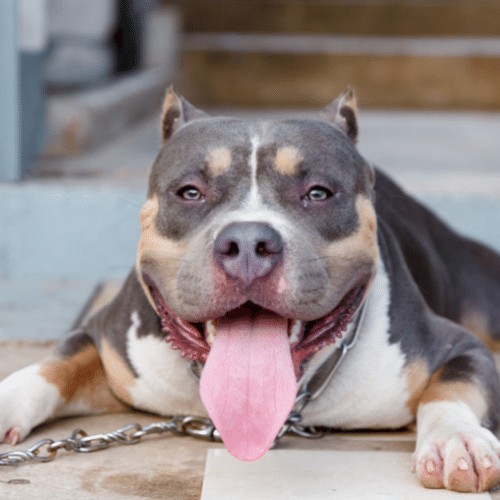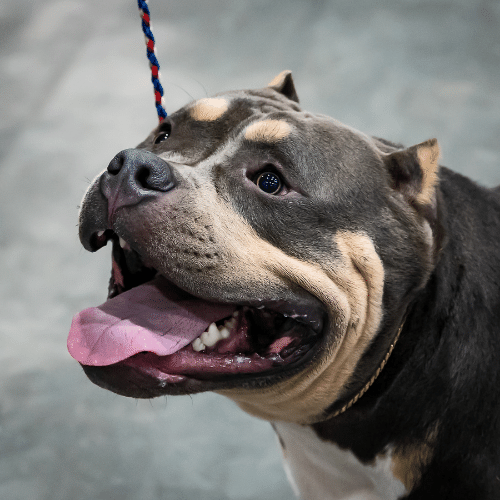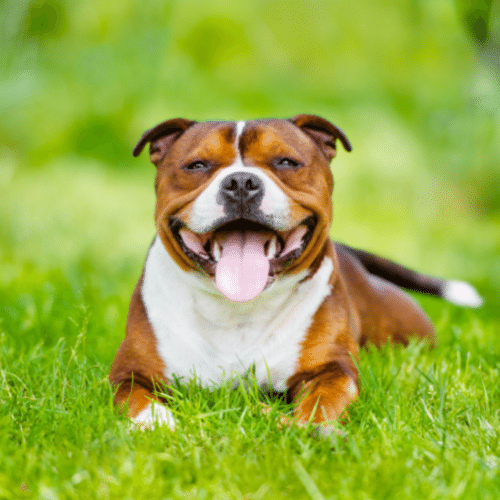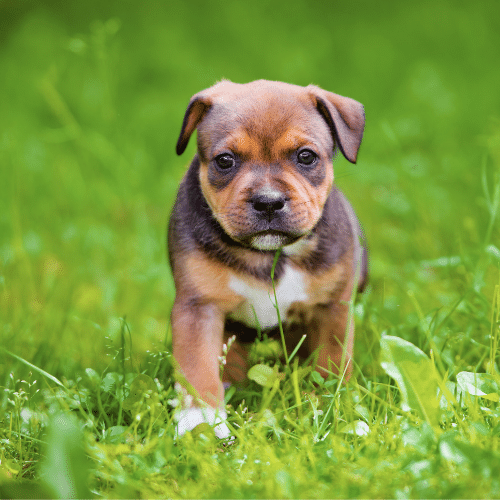Tri-Color Pitbull: What You Need to Know
September 9, 2021 2021-10-21 2:20While the term has been a bit muddled over the last decade, “pitbull” historically refers to the American Pit Bull Terrier breed. It is commonly used to refer to the American Staffordshire Terrier. These are technically considered the same breed by many, as it mostly just depends on what kennel club the dog is associated with.
This breed is medium-sized, usually weighing anywhere from 30 to 60 pounds. Males are often considerably larger than females. Their smooth, short coat is easy to take care of, though they do shed quite a bit.
Table of Contents

Appearance
Tri-Color Pitbulls weigh somewhere between 30 to 60 pounds. Males are typically at least a little bit larger than females. However, smaller males may be smaller than some females, so size isn’t always an accurate indicator of gender.
These dogs are quite muscular. After all, they were bred to take on larger prey animals. Their muscles are quire lean, though. They have a smooth, short coat that sheds quite profusely. Many of them need regular grooming for this reason.
Their ears and facial features vary by quite a bit. Small- to medium-sized ears are normal. They are usually completely pricked, but they make also have a small drop near the tip, similar to a bulldog.
Practically any color or pattern is accepted by most kennel clubs. The only one not accepted is merle, which is rare and only occurs in certain breeds. The Pitbull simply doesn’t have the genetics for it. Tri-color Pitbulls have three different colors, as the name suggests. Usually, their back is black, while their stomach and underneath of their neck are white. Their muzzle, chest, and legs feature a small amount of tan or brown.
This particular coloration is rarer, as breeders have not been making them until recently. It is caused by a recessive gene, so both parents must be this coloration to produce tri-color puppies. You typically have to purchase these puppies from a breeder, as they usually don’t occur accidentally.
History
The American Pit Bull Terrier was originally from England, despite the name. They were bred by crossing the Old English Terrier with the Old English Bulldog. This created a dog with the willingness of the terrier and the strength of the bulldog. It was originally called the Bull and Terrier dog due to its ancestry. This breed led directly to the American Pit Bull Terrier we know today.
Originally, these dogs were used for bloodsports. These included things like bull baiting. However, these were outlawed in Britain in 1835. While dog fighting was made illegal, too, many underground rings still existed, with this breed commonly being utilized.
These dogs were imported into America from 1845 to 1860, where dogfighting also took place. The Pit Bull was also used as a companion animal. They were sometimes utilized on farms as well, as they made good all-around companions. They would help farmers drive flocks, fight off wild boars, and then cuddle with the children at night. Many were able to wrestle feral cows and deal with larger animals that other breeds could not.
The United Kennel Club recognized this breed in 1898 as the American Pit Bull Terrier. The American Kennel Club didn’t recognize the breed until 1935. At first, the AKC didn’t want to recognize the breed. However, its growing popularity and the acceptance of the breed by other clubs forced their hand.
Still, they wanted to distance themselves from the breed’s past, so they renamed the breed to the American Staffordshire Terrier. It was originally claimed that this breed came from Staffordshire, England, but we don’t know how true this claim is.
Today, there is still some discussion over whether these two breeds are the same or whether they have since developed separately. There are some dogs that are registered under each kennel club under different breeds, which has led to some confusion.

Personality and temperament
The Tri-color Pit Bull is a friendly breed that has a zest for life. They are often very happy dogs that get along with just about anyone. Their adaptability makes them great for families, as they take rambunctious toddlers with stride. They can put up with a lot of children, which makes them great family dogs.
Many were referred to in the past as “nanny dogs” due to their close and easy relationship with children. They are typically very reliable with people due to their friendly nature.
These dogs are very good climbers and can often climb fences. Therefore, smoother fence materials are recommended. Privacy fences are often a suitable option, but chain-link fences can easily be climbed by most Pitbulls.
The Tri-Color Pitbull is relatively intelligent and has a high drive to work. They love competing in just about any canine sport. If they get to do something alongside their people, they’ll be happy.
Despite some misconceptions, these dogs do not make good guard dogs. They are a bit noisy and will typically bark when they see a stranger outside. However, this is more about their excitement at meeting a new friend than any sort of aggression. They can be good alert dogs due to their alert nature, but don’t expect them to act aggressively towards strangers that come into the home. They’ll likely just greet them with some licks.
While these dogs have been the target of breed-specific legislation over the years, they are actually not more likely to be aggressive than other breeds. Human aggression is a disqualifying factor for show dogs, so breeders are very careful to remove aggressive dogs from the breeding pool.
There are some statistics that show Pitbulls as being more likely to bite humans. However, there are several problems with this. Other breeds are much more likely to be mistaken as Pitbulls, especially when aggression is involved. Even vets and animal shelter workers are more likely to mislabel other breeds as Pitbulls.
Obviously, if you’re throwing several breeds into the Pitbull category, then it is going to artificially increase the bite statistics for this breed. Many more aggressive breeds, like the Cane Corso, are often mislabeled as Pitbulls.
Other studies with purebred, correctly labeled dogs have shown that there is no correlation between a dog’s breed and its aggression level. Socialization often plays a larger role. You can make any breed aggressive if you do not socialize them correctly. At the same time, even aloof and more aggressive breeds can be made friendly through socialization. It’s all about what the dog experiences at a young age.
Many people claim that the Tri-Color Pitbull is more prone to dog aggression. You’ll find this common claim across many popular dog websites. However, studies have found that this is not true. Many Pitbulls interact very well with other dogs.
Training and exercise needs of a Tri-Color Pitbull
Your main focus of training should be socialization. Many of these dogs are very trainable. They listen to their owners efficiently and are intelligent enough to learn most commands. They are very people-oriented, so they usually listen well in most situations. The only expectation to this is when new, exciting people and dogs are involved.
They tend to have selective hearing in these situations. Their excitement and friendliness often get the best of them, so they may not hear their owners’ commands. They can’t be trusted off-leash for this reason. They may easily run off after new people instead of being recalled to their owners.
We highly recommend putting these dogs in classes of some sort. Group classes are best, as these provide some level of socialization as well as training. Often, it isn’t the actual training that these dogs need the most of (since they are pretty easy to train anyway). Instead, socialization is where the value in these classes really lies.
It provides your canine with the opportunity to socialize with many different people and dogs in a controlled environment. You know all the other dogs are safe, as they wouldn’t be allowed in the class without the proper vaccinations and health checks.

Health and care
Common health issues
Compared to other purebred dogs, these canines are pretty healthy. They aren’t prone to the many different health problems like other breeds. Still, these dogs aren’t completely healthy. There are quite a few conditions that they can develop – just like any breed.
Hip dysplasia is one of the conditions that Pitbulls are often genetically predispositioned to. This condition is inherited and causes the joints not to form properly. There are some environmental factors that can cause this condition as well, such as improper nutrition and excessive exercise. Eventually, this will lead to excess wear on the dog’s joints and arthritis-like symptoms.
This can be treated with medication and sometimes surgery. Supportive care is also available, such as supplements.
The Tri-Color Pitbull can also run into problems with their patella (kneecap). Sometimes, the groove on their femur where their kneecap sits does not form properly. This makes the kneecap unable to sit perfectly in it, which can make it easier for it to pop out of place. This can cause pain and damage to the surrounding area if it is not treated properly.
Treatment for this can vary. Sometimes, arthritis medication is required because the kneecap will damage the femur when it pops out. Other times, surgery may be needed to realign the kneecap into the correct position.
Thyroid problems commonly occur as well. The thyroid gland makes many important hormones that are required for the body to work properly. However, occasionally, the thyroid does not make the proper amounts of these hormones. This can cause dry skin, hair loss, skin diseases, weight gain, fearfulness, aggression, and other strange behaviors. If your dog suddenly starts acting weird, it may be due to its thyroid.
Demodex mange is a common problem for these dogs. These mites live in the hair follicles of the dog, causing skin irritation and hair loss. In most cases, a dog’s immune system keeps the mites from getting out of hand. This leads to mild, localized cases of dry, irritated skin, which can be treated quite easily with the proper medication.
However, Pitbulls are often immunodeficient when it comes to this disease, which means that their immune system will not fight it off properly. This leads to the mange getting out of hand. The whole body can become infected. Bloody and scabby skin isn’t uncommon. Secondary infections may occur due to the constant open sores.
Specific medications can prevent the problem from getting too bad, but quick treatment is necessary. Many dogs will need lifelong maintenance. Usually, this disease isn’t deadly in itself, but the secondary infections could be if they are not tackled quickly.
Parvovirus is another disease that Pitbulls commonly have an immunodeficiency for. They are more likely to catch this disease when exposed and more likely to develop serious symptoms. Luckily, there is a vaccination for this disease. You simply need to make sure that your dog gets it and stay updated on shots.

Grooming
This breed requires minimal grooming. Their coat is short and smooth. It does a pretty good job of keeping itself clean. They do shed a decent amount, however. For this reason, we recommend brushing them at least once a week. This will help remove this dead fur, as well as other dirt and debris. Keeping up with their regular brushing sessions will elongate the time your dog needs between a bath. It will also spread out their natural oils, which will help keep their fur and skin healthy.
These dogs may need a bath occasionally when they get physically dirty. Otherwise, you shouldn’t have to worry about it. If they roll in the mud, you should bathe them. Otherwise, you can wait until they start smelling a bit dingy, which will take months.
Like most dogs, you will also need to trim their nails and keep an eye on their ears. While they aren’t prone to ear infections, any dog’s ears will get infected if they are allowed to get dirty. Therefore, you will need to clean them with a damp cotton ball whenever you notice built-up dirt and grime. This is true no matter what ear type your dog has.
Dental care is important as well. Many dogs get periodontal problems, which can be extremely troublesome. This can lead to infections and other issues. Gum disease can provide a direct port for bacteria into the bloodstream, which can mess with their heart, kidneys, and other organs.
While Tri-Color Pitbulls aren’t particularly prone to dental problems, any dog will develop dental problems if their teeth are not cared for properly.
Adopting a Tri-Color Pitbull
While Pitbulls are decently common throughout much of the United States, tri-color Pitbulls are not. This is a rare recessive gene that usually requires particular breeding. Therefore, it is difficult to find these dogs outside of a breeder. You’ll likely need to find a breeder that specializes in these colors.
Because this coloration is a bit rare, it can be a bit expensive. It largely depends on the breeder you purchase from, though. Some may charge as much as $35,000 for a puppy. Most puppies are around $5,000. It isn’t uncommon for the “1st pick” puppy to cost as much as $7000, though.
Of course, purchasing from a breeder is the most expensive option. You may be able to purchase from a rescue instead. However, this particular coloration is rare, so it can be particularly difficult to find from a rescue. Many of these dogs are often adults. Puppies are even rarer.
Most breeders are so expensive because they put a lot of money into their puppies. Health testing is common, which can get quite expensive. Many breeders health test parent dogs before they are bred together. This helps ensure that the adults don’t have any underlying conditions that are then passed onto their puppies. Some also perform testing on the puppies after they are born, ensuring that they aren’t carrying certain conditions.
Furthermore, many breeders know how to socialize their puppies properly. Most are raised in the home, which means that they will be used to common household noises. This makes them more adaptable to your home after adoption. After all, they’ll already know what a home is.
Most puppies also receive plenty of health care when adopted from a breeder. The puppy’s first vaccinations are usually covered by the breeder. The large majority of puppies are taken to the vet at least once before they are adopted. For this reason, they tend to be a bit more expensive. These prices often get wrapped into the cost of the puppies.
Experience level for owning a Tri-Color Pitbull
Pitbulls are not the hardest dog to own by any means. They are easy to train and quite friendly, which can make them a good choice for new owners. You typically don’t have to deal with common behavioral problems, especially if you take your dog to training classes. Socialization and training are important, but they are quite easy to properly do with these Pitbulls.
However, they are quite active. Many can even be described as hyperactive. They are basically terriers in larger, muscular bodies, after all. They can run around and become extremely excitable with strangers and new dogs. This can be a lot to handle.
They are best for active owners who have plenty of time on their hands, especially at first. Adopting a Tri-Color Pitbull as a puppy can be particularly troublesome, as they tend to be more hyperactive than adults.

In the end, these dogs can be suitable for new owners as long as you know what you’re getting into. If you are an active family, then you’ll be able to keep up with this dog better than other families. However, you should avoid this breed if you aren’t super active or don’t have the proper time for socialization.
They are absolutely harder dogs for first-time owners. But it is possible.
The bottom line
There are a lot of misconceptions about Pitbulls. While they are often the target of breed-specific laws, there isn’t any evidence that they are any more aggressive than any other breed. In fact, there isn’t any evidence that a dog’s breed is an accurate prediction of their level of aggression.
Pitbulls make great family dogs in most cases. They are very friendly and good with children. Many refer to them as “nanny dogs” for this reason. They are a great choice for children of all ages, as long as the adults can keep up with their activity level. Compared to other breeds, they are quite active. They need a decent amount of exercise, though their endurance isn’t terribly high.
These dogs are extremely trainable, which does make them a good choice for beginners. However, they are distractable and may not listen appropriately when new people and dogs are in the area. For this reason, they aren’t the most trustworthy dog. Their people-oriented nature does make them quite easy to train, though.

Author: Kristin
Kristin was born in Tennessee and currently lives there with her husband and children. She is passionate about educating pet parents and helping them make the best possible decisions for their pets. She currently owns one dog, two cats, a lizard, and a variety of fish.

